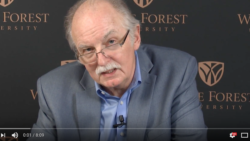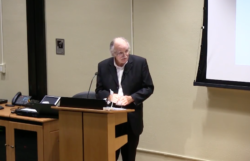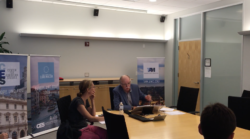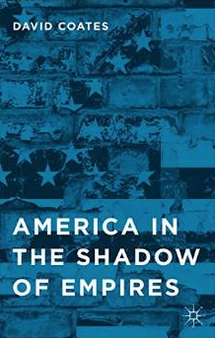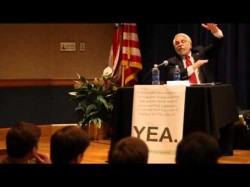America in Trouble
First posted on the Comment page of the Sheffield Political Economy Research Institite (SPERI) website, University of Sheffield, UK
Watching the economic policy debate in both Washington and London is a deeply frustrating experience. The debate in the UK is at least clearly focused – on the adequacy or otherwise of Osborne’s policy of deliberate austerity – and from that debate real policy emerges. The equivalent debate in the US isn’t even focused. Instead, it is deadlocked in a debate between two fundamentally incompatible positions in a political system that makes a virtue of divided government. The looming result right now is a series of severe cuts in public spending – the so called sequester – cuts that nobody is supposed to want but which are kicking in automatically because there is no agreement to stop them.
The only bright spot on the horizon, if it can even be thought of in those terms,, is the manufacturing strategy laid out by the President in his recent State of the Union Address: a new set of public/private partnerships to create global centers of excellence in high-tech manufacturing and to rejuvenate cities/regions hit by deindustrialization, plus more tax incentives for corporations bringing jobs back to the United States – corporations, that is, willing to employ a labor force re-skilled for the “jobs of the twenty-first century.”
To a British ear, all that must sound both remarkably familiar and extremely modest. It certainly did to mine. But so it should: because the most striking feature of the relationship between federal politics and the national economy in the contemporary United States is the gap between the enormity of the problems that need to be addressed and the banality of the policy solutions being canvassed to address them. The US economy is currently flat-lining. Its rate of job growth is barely keeping pace with the rate of entrants to the labor market. One American in seven is now officially poor. One American family in two has less than three months of financial reserves, should unemployment/illness strike. The median wage has been effectively stagnant for a generation. And all the President has new to offer are a set of glorified research triangles and the usual corporate tax-breaks.
That doesn’t get anywhere near what is needed because in truth, the barriers to rapid economic growth in the contemporary US are both interlocked and daunting.
The most obvious one is the political deadlock in Washington, and the enthusiasm of the Republican Party there for a slash and burn growth strategy: cutting public programs on the premise that their presence is a barrier to private sector expansion. (Republicans in my state – the one with the third highest jobless rate in the country – just cut unemployment benefits by 30 percent.) Add to that the continuing absence of private sector expansion – the inadequacy of investment and hiring by US companies large and small. That inadequacy is actually created by weakness in domestic consumer demand, and so it is one that cuts in public spending are already making worse and that the sequester will seriously amplify. Then there is the appalling hangover from the failed growth strategy of the Reagan/Clinton years: the sheer economic burden of massive family and student loan debt, of a broken housing sector still beset by foreclosures, and of enormous income and wealth inequality. Mix in too a decade of outsourcing of employment by major American companies (2.4 million jobs shipped overseas in a decade) and America’s growing dependence on export markets (particularly in Europe) which are also in trouble. Then bear in mind the sheer physical scale of this country. Unlike the UK, it is huge. You can be unemployed and yet physically miles away from any available work. The result, in a state like North Carolina where I live, are whole areas that are fully denuded of even low-skilled manufacturing employment, with their people locked away in eroding and isolated local economies that contain no inner dynamic of growth. That is a dire economic cocktail that a few additional corporate tax breaks doesn’t even touch.
There are definitely two Americas now. One is the America most visible from the other side of the Atlantic; with its recovering financial sector, its large pharmaceutical companies, its big arms producers and well-subsidized agribusinesses, and its high-spending managerial class. The other is the less visible America of sprawling suburbs, small towns and isolated hamlets – each with its standardized set of fast food restaurants and big-box retail stores, its low and stagnant wages, its hard-pressed public schools, and its deep divisions of class, ethnicity, religion and even (as here in the new south) on occasion divisions of language. That second America is hurting economically right now, and is struggling both socially and personally. The inability of the political class in Washington to address its growing needs both feeds the libertarianism of the American Right and speaks to the on-going inadequacy of the American center-left.
I know that things are tough economically and socially in Britain now, and across the whole of southern Europe. But just for the record, for too many Americans, they are very tough here too. This is a shared crisis, and I hope we all remember that.
Tags: Barack Obama, consumer demand, George Osborne, inequality, manufacturing strategy, North Carolina, outsourcing, personal debt, poverty, Republican Party, Washington Gridlock
David Coates holds the Worrell Chair in Anglo-American Studies at Wake Forest University. He is the author of Answering Back: Liberal Responses to Conservative Arguments, New York: Continuum Books, 2010.
He writes here in a personal capacity.
